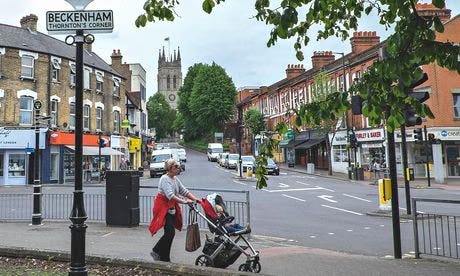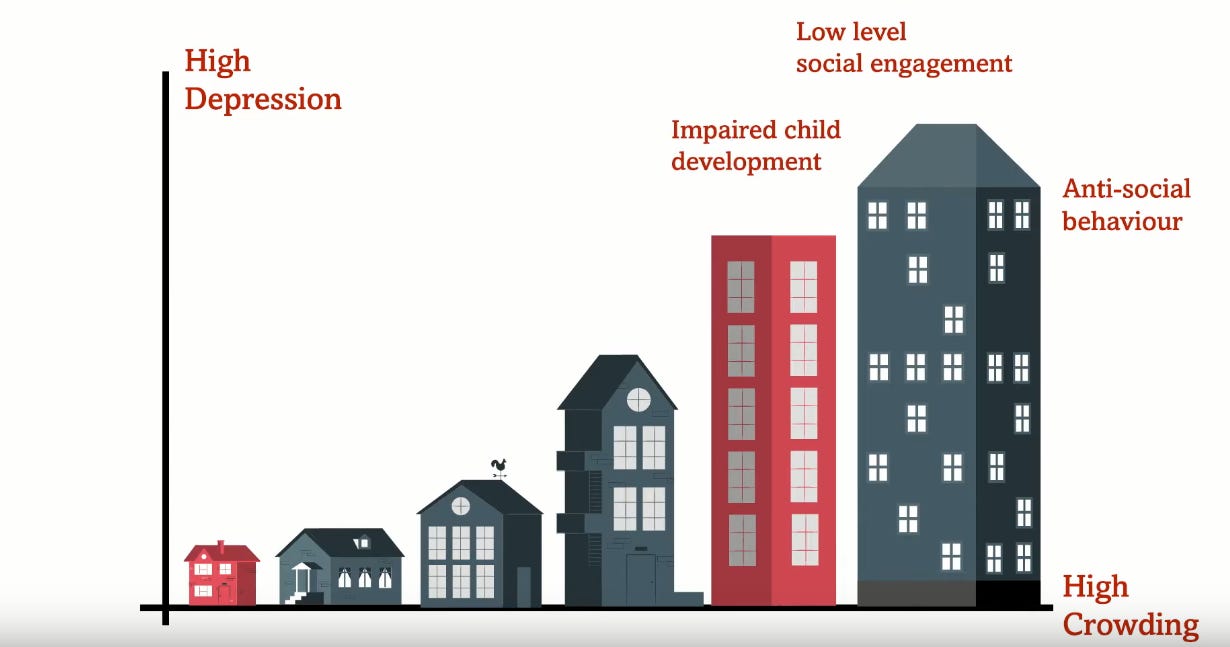The YIMBY Alliance aren't YIMBYs, they're just city boosters
It isn’t YIMBY to tell people they can’t have the suburban life they want and offer a mansion flat without outdoor space, nowhere for the car and economic opportunities dependent on public transport
The “we say we’re YIMBYs but aren’t really” tendency that uses the name YIMBY Alliance are back again arguing that urban densification and city boosting is the solution to Britain’s housing problems. As usual they draw on the work of urban booster think tank the Centre for Cities and argue that densification would make Britain’s cities more like those paragons of successful places with affordable housing like Barcelona. The city booster housing argument runs like this:
Low-intensity makes homes scarce and less affordable in high-demand areas, and new homes are built in increasingly rural areas.
It hampers labour mobility and weakens growth prospects by forcing workers out of cities.
Suburbs with small populations are unable to support effective public transport links, increasing commute times and car-dependancy.
Access to childcare becomes harder as schools and workplaces are often far from the family home.
Suburbs exacerbate the decline of the high street as communities become less walkable, reducing footfall for shops and suppressing local demand.
Broader civic life worsens as community infrastructure becomes harder to access, particularly for older people and families.
One of the criticisms rightly levelled at NIMBYs is that their policies act to force people to live in places and/or housing types where they don’t want to live. The effect of NIMBY dominated planning policies is for us to get the wrong housing in the wrong places. It is disappointing therefore that the YIMBY Alliance promotes ideas that will result in the same outcomes as the NIMBY policies they claim to oppose. Central to the YIMBY Alliance’s proposals is the idea, clear from the arguments above (which come from their social media) that suburbs are bad and dense, apartment living is good. Moreover they claim (without any evidence) that if you empower communities they will get together and turn all of England’s suburbs into Maida Vale.
The problem for our YIMBY Alliance is that the revealed preferences of actual home buyers lean towards suburbs and single-family housing. The US Society of Realtors - and UK home buyers won’t be a lot different - tell us about those preferences from their research:
“...most Americans would like to live in walkable communities where shops, restaurants and local businesses are within an easy stroll from their homes and their jobs are a short commute away: as long as those communities can also provide privacy from neighbours and detached, single-family homes. If this ideal is not possible, most prioritise shorter commutes and single-family homes above other considerations.”
Britain is a suburban nation. Using ONS definitions, the Leadership Centre, a think tank, concluded that 80% of English homes are suburban. This is not a new phenomenon, indeed Britain has, because of the planning system, become less not more suburban. Yet the YIMBY Alliance who tell us that they “want to see better places and more homes built with the support of local communities” are opposed to the sort of homes that most ordinary families aspire to: a house with a garden and somewhere to park the car within easy reach of local amenities and convenient for work. Instead they want six or seven storey mansion blocks that even their friends at Create Streets acknowledge are bad for child development:
It is no surprise that a very common feature of extremely dense urbanism is very low rates of fertility and few children. Yet despite this evidence city boosters persist in arguing for more densification often with the rather naive view that these high rise developments will be like Maida Vale not Broadwater Farm.
The YIMBY Alliance’s anti-suburb views are not remotely in the interests of resolving Britain’s housing problems and there’s a good argument that their ideas would simply slow down the rate of development as well as contributing to other social ills including the collapse of families, poor mental health and higher crime. The reason these YIMBYs hate suburbs come from a combination of US anti-suburb literature (hence the term ‘car-dependency’) and an attitude to European cities that demographer Wendell Cox called “Louvre Café Syndrome”:
“Tourists, journalists and urban planners are often smitten with what might be called the “Louvre Café Syndrome.” This occurs when Americans sit at Paris cafes in view of the Louvre and imagine why it is that the United States does not look like this. In fact, most of Paris doesn’t even look like this, nor do other European urban areas. Like their US counterparts, European urban areas rely principally on cars for mobility (though to a somewhat lesser degree) and their residents live in suburbs that have been built since World War II.”
We should, however, consider these YIMBY objections to suburbs and ask whether they have any real substance in fact.
The first objection is that low density development leads to higher house prices and to new homes being built in “rural areas”. This seems to be little different from the typical NIMBY argument about development and is driven almost entirely by the lack of land supply under Britain’s planning system and by the effect of, in effect, banning suburban development by putting nearly all of the “high demand” areas in the Green Belt. Instead of calling for the relaxation of London’s urban growth boundaries so places like Amersham can grow, the YIMBY Alliance indulge the NIMBYs and argue for suburban densification. With the repeal of the 1947 Town & Country Planning Act and the 1990 Planning Act people would be free to build new homes where people want to live rather than where planners and city boosters want them to live. The YIMBY argument seems to be that we can meet housing needs by building much smaller homes in flatted developments rather than by letting people who own land build houses on that land.
Of course the city boosters masquerading as YIMBYs have an economic argument, telling us that suburbs hamper labour mobility and weaken growth prospects by forcing workers out of cities. But maybe those workers are happy to have their mobility and growth prospects hampered so they can, as the song goes:
Find the one you can’t live without
Get a ring, let your knee hit the ground
Do what you love but call it work
And throw a little money in the plate at church
Send your prayers up and your roots down deep
And add a few limbs to your family tree
And watch their pencil marks
And the grass in the yard all grow up
Suburbs make this possible while keeping the connection to the city and the obsession with utilitarian economic arguments really do remind us that most YIMBY activists are single and childless.
And people in suburbs have cars which means that they have access to a much bigger range of work opportunities compared to people constrained by where the fixed line railway or the infrequent bus goes. As geographer Joel Kotkin observed about Los Angeles:
“If you want a job in Southern California, it is very useful to have a car. The average worker in the Los Angeles metropolitan area (which includes Orange County) can get to fewer than 1 percent of the jobs by transit in 30 minutes. By car, the average worker can get to 33 times as many jobs, according to University of Minnesota research. In Riverside-San Bernardino, the average worker can get to nearly 100 times as many jobs by car as by transit in 30 minutes.”
Our YIMBY urbanists talk of car dependence when the reality is that the car provides access, even in congested cities, to vastly more economic opportunity than trains or tramways. A new ‘car-dependent’ suburb North of London built inside the M25 wouldn’t just provide its new residents with access to central London but also to work via the motorway across Hertfordshire, Buckinghamshire and Essex. The term ‘car dependent’ is as stupid a term as saying your house is ‘fridge dependent’!
Finally our densification obsessives tell us that suburbs are distant from childcare, schools, high streets and community infrastructure. It seems that none of these experts have visited any of London’s suburbs because these place already have schools, kindergarten, colleges, doctors and thriving high streets. And if we allow new suburbs to grow they will, because that’s what families want, be built as extensions to existing places with all this social infrastructure. The YIMBY Alliance seems to have a view of suburbs based more on a song by Malvina Reynolds than any actual real world knowledge of suburbia.
There is no reason to suppose that a new generation of suburbs would be different from Beckenham, Sutton, Pinner or Romford but the city boosters want us to believe otherwise. That the YIMBY Alliance describe suburbs unlike any actual suburbs seems odd, almost as odd as people arguing for “yes in my back yard” but then saying “no not in that back yard over there because people might have a car”. Britain has more than enough land to allow families to have what they want: a house, a garden, somewhere for the car, all close enough to work, shopping, school and play to be convenient. It isn’t YIMBY to tell people they can’t have the suburban life they want and instead offer a sixth floor mansion flat with no private outdoor space, nowhere for the car and economic opportunities limited by where the train goes.




A few things to unpack there. My hunch is the TCPA did a lot to polarise the geography of class. In contrast to London (and especially the North and Midlands) the closer your are to the centre the of town the poorer people become, and the more likely they are to have lived for decades next to derelict land, as you go out the edge people become more affluent and more likely they are to live next protected greenbelt. When you ask why those people live next to derelict land for decades the answer is economics, and when you ask why people on edge live for decades next protected green land the answer is values. It’s a rhetorical sleight of hand that once you see it, you can’t unsee it, and it’s deeply divisive. Northern cities have managed to export their most affluent and articulate members to the periphery, and they leverage their political power to the detriment of other communities. Through that lens ‘brownfield first’ becomes argument made by one community to ensure it can continue to live in low density, drive cars beside fields, while another community is forced into high density, and less access to green space. So I’m with your libertarian instincts in the sense both should be subject to the same land use economics (or the same land use values), and suburbs are indeed fine, but they should be allowed to organically thicken up and extend. Hard not to agree that suburbs, at least in developed economies, are fundamental to fertility.
We're probably going to need both suburbs and mid-rises. Economic research shows that large wave migration which self-segregates into culturally homogenous zones is far less likely to experience intergenerational social mobility. The incomes stay flat for self-imposed reasons: https://link.springer.com/article/10.1007/s00168-019-00953-8#Tab4
Our more moderate migration was so successful at achieving high levels of 2nd generation social mobility precisely because it was more moderate migration, inherently more likely to aid high levels of integration.